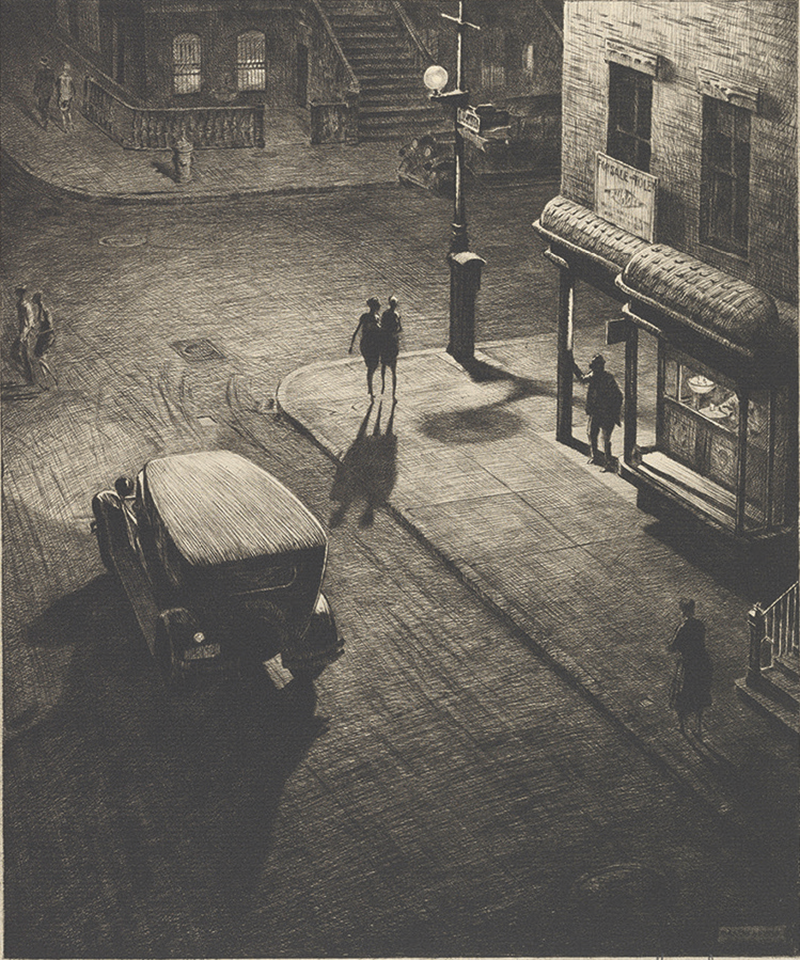Revolver shots at three in the morning. As I stuck my head out the window, lights flared up and down the darkened block. More heads craned from open windows. Below me, across the street, a man lay writhing on the sidewalk while two policemen bent over him. One of the policemen was beating the man with a nightstick.
Immediately, as though they had sprung from the sidewalk, an additional audience—well-dressed and well-behaved—gathered from the nearby nightclubs and speakeasies. After a pause the policeman bent over and laid into the man again.
I listened to the sickening thuck, thuck, thuck, in regular repetition, as when the club meets no defense, when the victim is incapable of dodging. It had a steady rhythm, like that of beating carpets, quite different from the irregular jabs and smacks of a fight. Presently the crowd began to disapprove. From a window a man shouted, “Lay off, can’t you?” A woman’s voice cried, “Oh, stop that, stop it!”—sympathy for the victim, disgust for the policeman, in her tone.
But the thuck, thuck, thuck began again, for the third or fourth time. The crowd had grown, and now I could see only the shoulders of the policeman as he bent intently to his task. By this time there were several other policemen about; surely there was no chance for the man to escape. This beating was revolting. I found myself shouting, “Go easy!” I heard a woman in the crowd remark cautiously but viciously to a man beside her, “Hope he killed a cop!”

Relics (Speakeasy Corner), 1928, by Martin Lewis © The Metropolitan Museum of Art/Art Resource, New York City. Originally published in the March 1929 issue of Harper’s Magazine
If exhibitions such as this are the policeman’s idea of endearing himself to the public, it is idle to expect liberty-loving people to “glorify the cop and not the gangster.” That steady, calculated beating up of a defenseless man had swung sympathy to the victim.
The accused will, I hope, get their deserts. But the patrolman who did the carpet-beating and his superiors who stood by, will they be punished? Will they receive even a fine for lowering the prestige of the department in the eyes of the public?
Everyone who lives in a big American city appears to have heard of similar cases of police brutality. There are innumerable other stories, true or false, of abominable third-degree cruelties which have not found their way into print but are widely circulated. Whether some of the stories are exaggerated or not matters little. What is important is that the public has seen enough brutality by police to believe all sorts of discreditable tales about them, and the reputation of the force suffers accordingly.
I have come to the conclusion that one underlying reason for police brutality is the absence of discipline in American police forces. A soldier recovering from fright is under the same temptation as a policeman to bully and mistreat his victim; a junior intelligence officer in the Army is under the same temptation as a lieutenant or captain of police to apply torture to secure valuable information from tight-mouthed prisoners. But the discipline of the Army is superior.
Newspaper reports, the conversation of friends, even the way in which people step hastily aside to avoid contact with a cop, offer proof of a suppressed resentment or hostility which cannot be wholly explained by the reputation of the police for brutality. The public attitude toward law-enforcement in general is that of a liberty-loving people in passive revolt against tyranny. The attitude of the police is that of an armed force using brutality, torture, and all the other methods of agents of a tyrant, with contempt for the constitutional liberties of the citizen.
Yet no foreign tyrant reigns from the White House. No alien army camps on these shores. Who is the tyrant? Whence comes the tyranny?
From “Why the Police Fail,” which appeared in the January 1933 issue of Harper’s Magazine.































































































